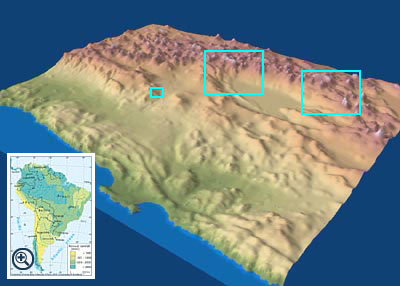 |
|
|
|
|
|
|
Fossil groundwater in the Andes |
|
|
An example of the importance of knowing more about past climate change The arid Andes between 18° and 30° South are located
in the transition zone between the tropical and westerly circulation belts.
This area is characterized by the extreme climate change of the last ice
age, e.g. with a humid period during the late-glacial and Early Holocene
time in a large part of the region. Today, precipitation
rates are lower than 150-200 mm per year. Results from paleoclimatic
research suggest that modern recharge of the water resources in this area
is very limited, or even below the level of detection. The groundwater
resources of today were formed when precipitation rates were two to three
times greater than at present. Thus, water is renewed extremely slowly,
or even non-renewable at present. |
1 - Chilean Altiplano (22-24°S), with mountains above
6000 m. |
Use the diagrams above to answer the questions below. |
1. Why might the water storage be quite limited
on the Chilean Altiplano today? |
2. What could certain stakeholders (mines, inhabitants of San Pedro, hotels)
do to reduce the amount of groundwater needed?
|
|
3. How could the mines be obliged to use less water?
|
29 August 2011 |
||
| |
||
